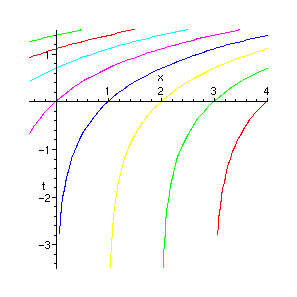> alias(u=u(x,t)):
for t >0
> dequ:=exp(t)*diff(u,x)+diff(u,t)=0;
![]()
initial condition for u(x,t), x >= 0 (t=0)
> uini:=cos(1/2*pi*x);
![]()
The characteristics are now given by
> charequ:=diff(t(x),x)=1/exp(t(x));
![[Maple Math]](images/example13.gif)
This could be solved by separating the variables, but using dsolve is more fun
> chars:=dsolve(charequ,t(x));
![]()
> chars2:=subs(_C1=C,rhs(chars));
![]()
Let's plot some characteristics
> plot([seq(chars2,C=-5..4)],x=-0.5..4,t=-3.5..1.5);

Now, as has been discussed in the text, u(x,t) is constant along these curves. Each curve cuts the x-axis just once and 'picks up' a value of u there, given by the initial condition
> u(x,0)=uini;
![]()
> newequ:=t=chars2;
![]()
Another vay to write the equations for the characteristic curves
> x=solve(newequ,x);
![]()
Hence the function u(x,t) can only have the form
> u(x,t)=F(x-exp(t));
![]()
From the initial condition
> F(x-1)=uini;
![]()
and by a simple change of variable
> F(x)=subs(x=x+1,uini);
![]()
Finally, do the substitution x -> x-ep(t) to get
> F(x-exp(t))=subs(x=x-exp(t)+1,uini);
![]()
This is the solution u(x,t) with the given initial condition.